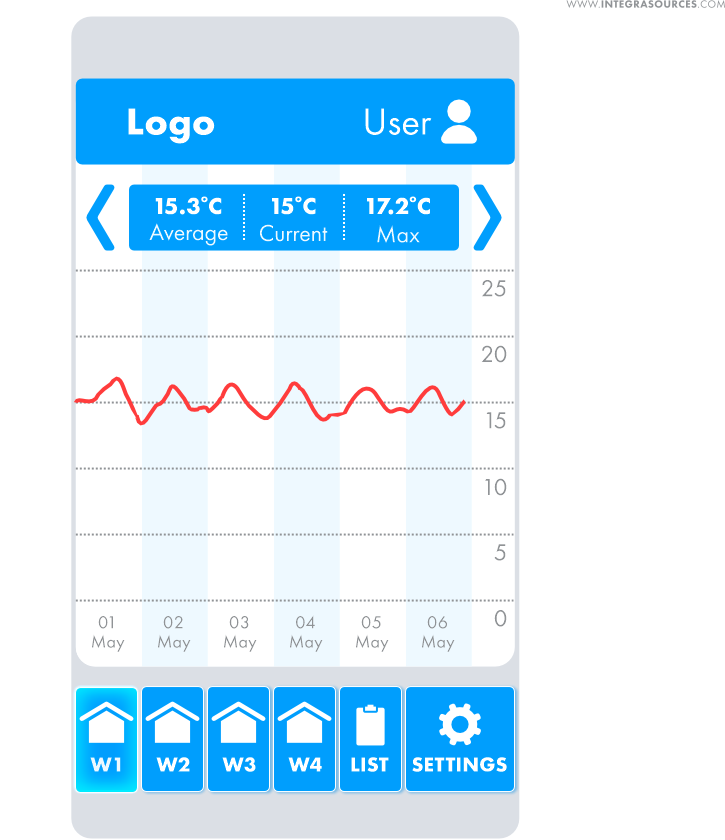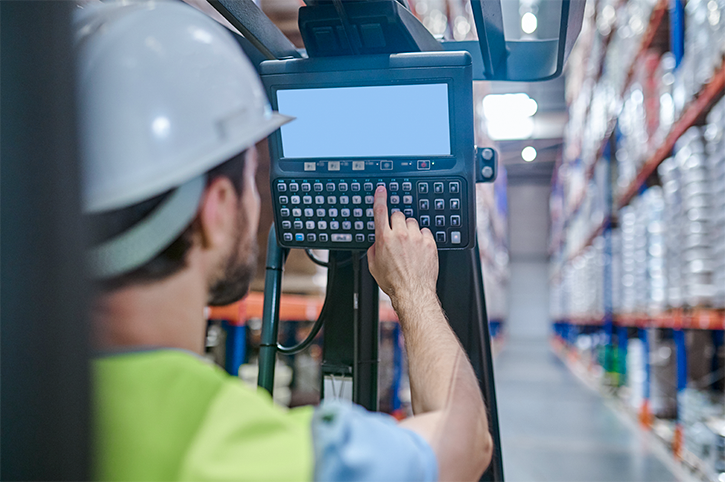This website uses cookies so that we can provide you with the best user experience possible. Cookie information is stored in your browser and performs functions such as recognising you when you return to our website and helping our team to understand which sections of the website you find most interesting and useful.
To Work Like a Clock: App Development for Logistics


Nina Bibikova
IT Writer, Specializes in Electronics and Software Development Topics

Andrey Solovev
Chief Technology Officer, PhD in Physics and Mathematics
- What Are the Types of Logistics Apps?
- Helpful Features of Logistics Apps & Use Cases
- Truck Tracking
- Best Routes
- Multilingual Support
- Offline Functions
- Communication with the Driver on the Way
- Network Protocols and Technologies Support
- Cross-platform App Capabilities
- How Could Transportation and Logistics Software Solutions Benefit Your Business?
- Outsourcing Logistics App Development: What to Keep in Mind?
- Rough Edges of Logistics App Development
- Conclusion
It’s impossible to imagine today’s economy without logistics. The global logistics industry is increasing year over year, having slipped just once at the beginning of the COVID-19 pandemic. The size of the logistics industry worldwide is expected to exceed 13.7 billion euros by 2027.
Logistics today cannot do without software solutions, embedded systems, IoTs, and robots.
The main competitive advantage in the logistics industry is delivery speed. Companies should deliver goods as quickly and safely as possible and receive, preferably in real time, the necessary warehouse and transportation data to obtain and maintain a competitive advantage.
Our review highlights application development for the logistics industry and the business benefits of implementing software solutions. We hope you will find it fascinating and helpful!
- What Are the Types of Logistics Apps?
- Helpful Features of Logistics Apps & Use Cases
- Truck Tracking
- Best Routes
- Multilingual Support
- Offline Functions
- Communication with the Driver on the Way
- Network Protocols and Technologies Support
- Cross-platform App Capabilities
- How Could Transportation and Logistics Software Solutions Benefit Your Business?
- Outsourcing Logistics App Development: What to Keep in Mind?
- Rough Edges of Logistics App Development
- Conclusion
What Are the Types of Logistics Apps?
Application types directly depend on the logistics area in which they are applied.
Fleet routing and management software applications are designed to collect, process, and store data related to logistics transport.
The app can track each vehicle's location and display it on a map using positioning systems.
Using the app, you can track and analyze significant indicators, such as fuel consumption, distance traveled, repair costs, and vehicle maintenance history. Application features may also include scheduled maintenance reminders.
By analyzing the data, a company can optimize routes and establish realistic forecasts, making the most of its resources.
By differentiating the access rights of app users, you enable each employee involved in the logistics process to receive the necessary information, enter data, or manage the logistics flow.
Asset tracking and warehouse applications can monitor the quantity and names of goods delivered to storage and help track items' shelf life and location.
Cross-platform mobile and desktop applications make warehouse management as efficient as possible.
Integra Sources developers have created an IoT system for a Canadian customer. We have carried out the project discovery phase and created warehouse devices equipped with humidity and temperature sensors. Gadgets transmit data 24/7 via LoRaWAN to the AWS server. We used Amazon Web Services, such as AWS Lambda, Amazon SNS, and AWS IAM to store and process data.
Being a logistic app development company, Integra has used the Qt framework's tools and built a cross-platform mobile logistics app for iOS and Android that receives and analyzes device data.

The service logistics C++ application displays real-time warehouse temperature and humidity, notifying the user when figures change above the permissible values since this data is crucial for maintaining the quality of the stored raw materials.
The app's functionality also contains statistical timeline reports of temperature and humidity fluctuation.

We have developed a monitoring system that allows the customer's company to reduce storage costs, minimize raw material losses, and increase business efficiency.
Warehouse software can be integrated into a single logistics management software system, allowing businesses to manage inventory levels, make production schedules, and ultimately reduce storage costs.
The logistics management system covers the entire logistics chain, from order processing to delivery of goods to the consumer, including return shipping.
Logistics management software implementation requires significant financial investments, but all the efforts pay off by saving resources and optimizing logistics processes.
The world's leading suppliers of logistics management systems are Germany's SAP and the United States-based company Oracle.
RFID technologies, speed and load weight sensors, shock sensors, and barcode readers make warehouse management easier.
Forklift HMI applications display all relevant data on the screen, allowing operators to assess the situation in real time and quickly perform material handling and transport operations.

With a mobile or desktop version of the warehouse application, warehouse managers can supervise the work of operators, generate reports, and analyze data related to one or more warehouses.
Innovations in the logistics industry, in particular the automation of warehouse processes, have been developing rapidly in recent years.
The size of the warehouse automation market in general is showing strong growth, increasing by $10 billion over the ten years from 2012 to 2022, with a forecast to rise by another $12 billion by 2026.

Source: Statista
Logistics companies introduce robots and drones into the working process to increase labor productivity and delivery speed.
The logistics industry is driving the growth of the autonomous IoT and robotics markets. Mobile logistics robots are expected to generate over $9.8 billion in revenue by 2025.

Source: Statista
Meanwhile, the size of the warehouse robotics market worldwide in dollar terms is projected to triple in the next ten years.
As a software and hardware development company with vast experience in robotics and IoT, Integra Sources will help you create transportation and logistics apps and software solutions, as well as develop robots and drones for your logistics business.
Helpful Features of Logistics Apps & Use Cases
No matter for what the app is intended, there are always some common points in the customers' requirements:
- Speed and efficiency,
- Reliability,
- Data security,
- Adequate price,
- Ease of use,
- Efficient data management,
- Integration with internal and external systems
Logistics applications also have unique scope-related features.

Truck Tracking
Applications can implement vehicle tracking functionality using real-time GPS location. Vehicle tracking allows drivers to better navigate, logistics companies to optimize delivery, and consignees to know where their cargo is.
Integra Sources has completed an order from a logistics company to develop a software and hardware system consisting of GPS devices installed on trucks and an app that saves GPS coordinates transmitted by sensors and displays them on the map.
We built a logistics app for iOS and Android using the Qt framework tools and C++, QML, and JavaScript.
Our developers used the Kalman filter to improve the accuracy of logistics vehicles' GPS positioning.
The customer got a simple and efficient real-time vehicle tracking system.
Best Routes
Just think that by having a mobile logistics app on hand, you can plan the shortest and best delivery route, saving time, fuel, and overhead costs. The consignee will receive the goods faster.
Route planning and optimization help solve the last-mile problem when consumers want fast and low-cost delivery, even though this is often the most expensive and long-running part of the logistics process.
We at Integra Sources have developed a navigation system for a delivery service company that helps the courier choose the best routes.
The manager assigns tasks to the courier through the web portal, indicating delivery addresses on the map. He receives the courier's GPS positioning data and stays informed about the courier's location.
Integra Sources' developers implemented mobile transportation logistics apps for iOS and Android using the Qt framework.

The courier uses a logistics planning mobile app that shows the shortest route calculated using mathematical algorithms.
The application sends notifications to the company manager and the shipper as soon as the courier marks the delivery of the cargo.
Multilingual Support
Misunderstandings and translation errors can be fatal when decisions are to be made quickly.
The multilingual logistics mobile app is convenient for drivers and foreign partners, and it will surely attract more customers to your company.
Offline Functions
The Internet connection is not always stable. If the mobile app has offline functionality, app users can enter data, view saved figures, and access reports even when the network is unavailable.
Communication with the Driver on the Way
Built-in messaging can be a very needed and wholesome communication channel among company managers, shippers, and drivers.
Logistics managers can find out about vehicle accidents or breakdowns on the road and adjust the route. Customers can get the necessary delivery data directly from the driver.
Network Protocols and Technologies Support
Asset tracking applications and warehouse software solutions typically communicate with IoT, robots, and sensor-equipped devices to obtain location, temperature, humidity, and other data. Applications can support various communication protocols, such as Wi-Fi, Bluetooth, NFC, and BLE.
Integra Sources has developed a customizable GPS tracking platform for monitoring assets. The system consists of a GPS tracking device with BLE, Wi-Fi, and GSM/HSPA communication interfaces and a cloud platform that saves the location and status of assets and displays that data to users in real time through a web interface and a mobile application.

A cross-platform application for iOS and Android with Google Maps allows employees to monitor the location of assets 24/7.
Asset tracking goes beyond the warehousing process and extends to logistics in general and other related areas.
Our developers have created a plug-and-play solution for localized online advertising of shops, restaurants, and other places using a distributed BLE beacon system, a web server, and an Android application for a UAE client.
Using the Android Studio IDE, we have built an SDK that can be integrated into any Android app.
The Android application uses the iBeacon protocol to receive data from beacons placed in shops, restaurants, and entertainment venues. The app then sends it to a web server that determines the user's location.
Information about discounts, sales, and promotions, stored on the server, can be sent to recipients via push notifications.

This system enables a variety of businesses, such as a small coffee shop, a boutique, or a cinema in a shopping and entertainment center, to effectively advertise their services and promotions to their target audience.
Cross-platform App Capabilities
Cross-platform logistics apps can run on iOS, Windows, and Android operating systems in mobile and desktop versions with minimal interface differences. Users can choose the most convenient way of using the app.
We described various tools for cross-platform application development in our blog articles. With the help of the Qt C++ framework, Integra Sources’ developers can create user-friendly and functional Qt apps for transport logistics, asset tracking, and warehousing with minimum time and effort.
How Could Transportation and Logistics Software Solutions Benefit Your Business?
Logistics mobile app development can bring plenty of benefits to your business and significantly improve financial performance.
The main benefits of implementing applications in the logistics industry are reducing logistics costs and minimizing human error by automating workflows.
Along with the pros listed, there are also significant advantages to integrating logistics management applications into your business processes:
- Good company image
The user-friendly interface of the logistics app speaks of the company as technically advanced, modern, and customer-oriented.
- Automated fleet tracking and management
The manager receives real-time data on the state of the company's vehicles and can adjust routes and load online.
The mobile application provides information about the truck's location, the distance traveled, and the estimated arrival time. Data related to drivers, trucks, and cargo are collected in one place and are always available.
- Customer trust and confidence
By offering logistics technology services related to obtaining real-time cargo location data, companies provide customers with confidence in shipment safety and compliance with delivery times.
If the delay nevertheless occurs, the customer receives comprehensive receipt timing data for the goods and never remains in ignorance.
- Fewer paper documents
Employees save resources and time by using logistics apps as part of the logistics reporting system and not storing printed paper documents.

Outsourcing Logistics App Development: What to Keep in Mind?
When developing a logistics application, a software development company should study the customer's wishes regarding the software solution. The requirements may take into account the following points:
- the app platform (mobile, desktop, or web),
- the operating system,
- the app’s functionality,
- wishes related to the UI design
In most cases, logistics apps interact with various devices, sensors, and trackers.
The outsourcing team should receive from the customer a description of the device with brief technical characteristics as well as equipment communication protocols.
Engineers need device certification requirements if the project involves hardware development with subsequent certification.
Rough Edges of Logistics App Development
Like all other technology solutions, logistics applications can have drawbacks. Let's discover the main possible failures and consider how to avoid them.
Unfriendly UI
Many end-users complain to CIOs in the transport and logistics industries about the intricate and user-unfriendly menus of logistics apps.
Complex menus can cause inconveniences when you need to quickly arrange the loading of goods or enter data on the way.
Entrust UI development to competent software specialists and get a user-friendly application.
Insufficient functionality
Insufficient app tailoring to the needs and roles of employees leads to unnecessary functions and the lack of those that are necessary.
It's better to undertake preparatory work and choose the required functionality before app development to get an application that meets your business needs.
Not enough update frequency
Like any other software product, logistics mobile applications should be updated regularly. The company must devote sufficient time and resources to these processes.
No cross-platform capabilities
Native mobile application development is not always suitable for logistics companies where employees use personal smartphones with different operating systems.
Cross-platform applications can be deployed on multiple operating systems and look and perform just as well as those that are native.
Lack of security
Data can be lost or corrupted accidentally or intentionally. The solution is to develop a secure login system and differentiate user rights to increase data security.
Low or no connectivity
If the Internet connection is unstable, the entered data may be lost or the application may be unavailable.
With offline features, the app stays helpful even when you're not connected.
High Cost
The more complex the application, the higher its cost, and the more difficult it is to update it every time. Adding extra features also costs money.
Carefully determine which app features are required, and then remove all unnecessary ones. The right choice of the technology stack for app development can also reduce the project's overall cost.
As we can see, most issues can be resolved by involving competent specialists in logistics app development.
Conclusion
The Olympic slogan “Faster, Higher, Stronger” fits perfectly with all the changes taking place in the logistics industry today.
To withstand the whirlwind of competitors, companies must provide logistics services in the shortest possible time while ensuring the safety of the cargo and customer awareness at all stages of the process.
In this regard, logistics applications bring both the company and the client invaluable benefits.
Simple and user-friendly software solutions can save you time and nerves by reliably providing vehicle location data, building optimal routes, and signaling emergencies.
Integra Sources specializes in custom software and hardware solutions. Share your ideas with us, and we won’t disappoint you with the result.
Share this article


Related
materials


Drone Autopilot
The hardware unit based on the Atmel AVR XMEGA microcontroller provides remote control of the drone and autonomous flight performance.
LEARN MORE
LEARN MORE


Industrial App Development: A Silver Bullet to Wipe Out Manufacturing Challenges
Software for industrial solutions is unique in its functions and characteristics. Cross-platform features allow employees to monitor production processes from...
LEARN MORE
LEARN MORE

IT Project Discovery Phase: What's That, and What Does It Do?
The project Discovery Phase is aimed at helping you arrange a flawless development process that will provide you with suitable...
LEARN MORE
LEARN MORE


